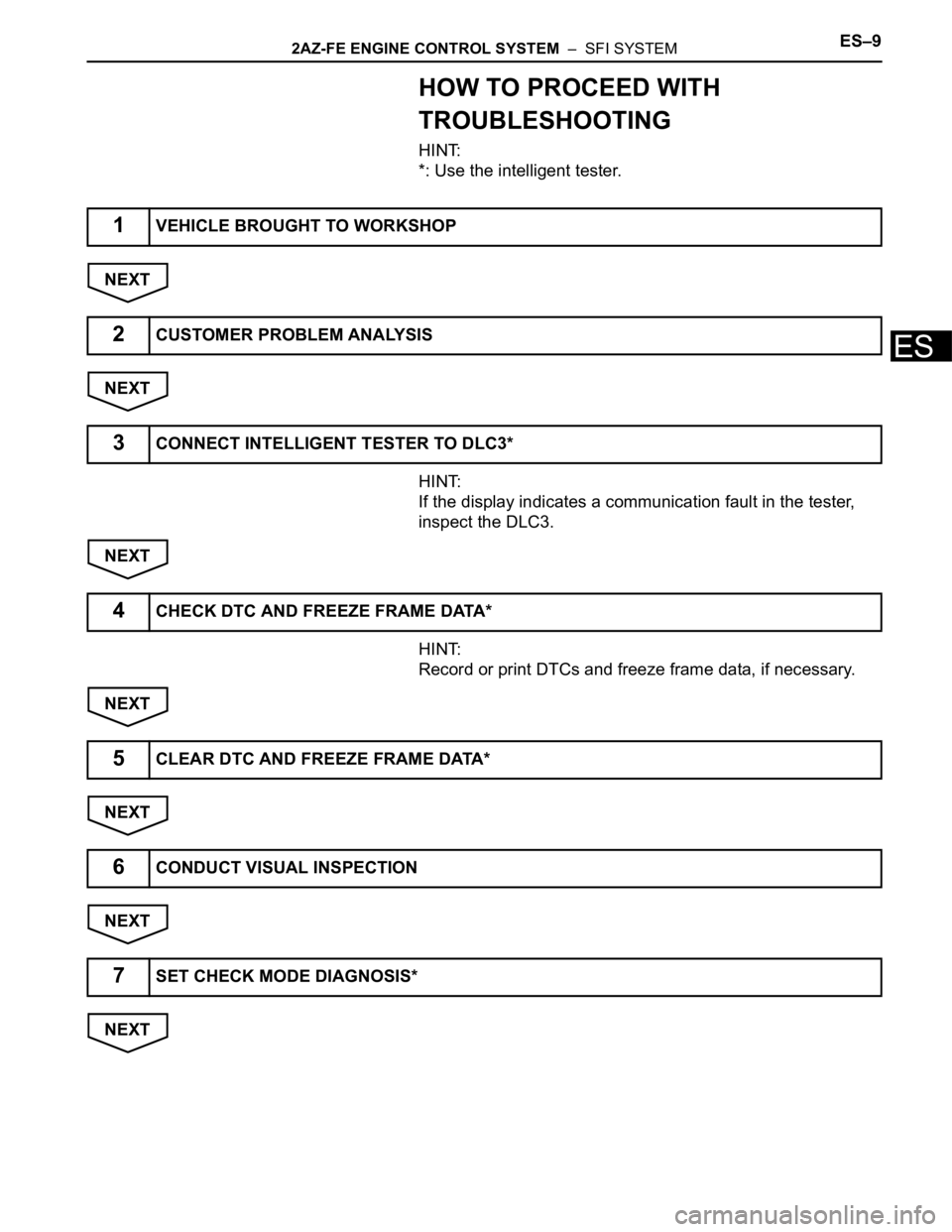2006 TOYOTA RAV4 ECO mode
[x] Cancel search: ECO modePage 55 of 2000

ENGINE - 2AZ-FE ENGINE
00REG23Y
To Intake Manifold
Atmosphere
Purge VSV
(Open)
ECM
00REG24Y
CloseOpen EG-58
System Operation
1) Purge Flow Control
When the engine has satisfied the predetermined conditions (closed loop, engine coolant temperature
above 74
C (165F), etc.), the stored vapor gas are purged from the canister whenever the purge VSV
is opened by the ECM.
The ECM will change the duty ratio cycle of the purge VSV, thus controlling purge flow volume. Purge
flow volume is determined by intake manifold pressure and the duty ratio cycle of the purge VSV.
Atmospheric pressure is allowed into the canister to ensure that purge flow is constantly maintained
whenever purge vacuum is applied to the canister.
2) ORVR (On-board Refueling Vapor Recovery)
When the internal pressure of the fuel tank increases during refueling, this pressure causes the diaphragm
in the refueling valve to lift up, allowing the vapor gas to enter the canister. Because the vent valve is
always open (even when the engine is stopped) when the system is in a mode other than the monitoring
mode, the air that has been cleaned through the canister is discharged outside the vehicle via the fresh
air line. If the vehicle is refueled in the monitoring mode, the ECM will recognize the refueling by way
of the canister pressure sensor, which detects the sudden pressure increase in the fuel tank, and will open
the vent valve.
Page 62 of 2000

ENGINE - 2AZ-FE ENGINE
01NEG13Y
Generator
RegulatorB
DF
RLOECM
Various Electrical
Loads
Battery Current Sensor
Battery Temperature Sensor
Battery Voltage
Battery
Various Sensors and Switches
Throttle Position Sensor
Crankshaft Position Sensor
Accelerator Pedal Position
SensorEG-65
11. Charging Control
General
This system lowers the generated voltage when the vehicle is idling or is being driven at a constant speed,
and raises the generated voltage when the vehicle is decelerating. This reduces the load on the engine as
a result of the electric generation of the generator, thus contributing to the fuel economy of the engine.
During acceleration, this system regulates the generated voltage in order to place the amperage estimation
value close to the target value.
This control consists of the ECM, battery current sensor with a built-in battery temperature sensor,
generator, and various sensors and switches.
The ECM detects driving condition based on signals from various sensors and switches, and detects
charging condition based on signals from the generator, battery current sensor and battery temperature
sensor. Then the ECM outputs signals to the IC regulator to control the genetated voltage of the generator.
The ECM stops the charging control and the generator switches to normal power generation mode under
the following conditions:
Low battery capacity
Low or high battery temparature
Wipers operating or blower motor operating with tail lamp relay ON
System Diagram
Page 133 of 2000

CHASSIS - 4WD SYSTEM CH-66
4WD SYSTEM
DESCRIPTION
The 4WD system of the ’06 RAV4 uses an active torque control 4WD system.
It is a compact, lightweight, and high performance 4WD system that optimally controls the torque
distribution to the front and rear wheels through the electric control coupling in the rear differential.
ACTIVE TORQUE CONTROL 4WD SYSTEM
1. General
Based on information provided by various sensors, the 4WD ECU controls the amperage that is applied
to the electric control coupling, in order to transmit drive torque to the rear wheels when needed, and in
the amount needed. The following describes the features of the active torque control 4WD system.
Traction performance
Realizes stable start-off and acceleration performance
Driving stability performanceRealizes stable cornering performance
Fuel economyRealizes better fuel economy by transmitting drive torque to the rear
wheels when needed, in the amount needed.
A four-wheel drive lock switch has been provided. This enables the driver to select between the AUTO
and LOCK modes by operating the switch. The system optimally controls the torque distribution to the
front and rear wheels in the respective modes.
Mode
Four-wheel Drive
Lock Switch and
Indicator Light
Outline
AUTOOFF
Optimally distributes drive torque to the front and rear wheels.
Ensures optimal start-off performance during a start-off, based on
information provided by various sensors.
Suppresses the tight corner braking phenomenon* during low-speed
cornering.
Reduces the amount of torque distribution to the rear wheels and
improves fuel economy when the system judges that the vehicle is
traveling steadily.
Disengages the 4WD during braking deceleration.
LOCKON
Distributes the maximum torque limit to the rear wheels.
Distributes the maximum torque limit to the rear wheels during
start-off.
Distributes optimal torque during low-speed cornering.
Disengages the 4WD during braking deceleration.
Disengages the LOCK mode and transfers to the AUTO mode when
the vehicle speed exceeds 40 km / h (25 mph).
*: Tight corner braking phenomenon: a condition in which the brakes are applied due to a rotational difference
between the front and rear wheels, such as during low-speed cornering in the 4WD mode.
The 4WD ECU effects cooperative control with the skid control ECU, in order to control the drive torque
distribution to the front and rear wheels in accordance with information received from the skid control
ECU. These controls ensure a smooth acceleration and driving stability.
Page 137 of 2000

CHASSIS - 4WD SYSTEM
01NCH38Y
Torque Distribution
to Rear WheelsTorque Distribution
to Rear Wheels
Straightline Driving Low-Speed Cornering
01NCH39Y
Torque Distribution
to Rear WheelsTorque Distribution
to Rear Wheels
Steady Driving Straightline Acceleration
NOTICE
In the LOCK mode after the four-wheel drive lock switch is pressed, the system starts control upon
judging that the vehicle is operating in a stable manner. During this judgment, the 4WD LOCK
indicator light blinks.
CH-70
5. System Operation
Auto Mode
1) Starting Off
The system ensures start-off performance by optimally distributing the entire drive torque, which is
transmitted by the engine, to the front and rear wheels.
To prevent the tight corner braking phenomenon from occurring during low-speed cornering, the
system reduces the amount of torque distribution to the rear wheels.
2) Normal Driving
During normal driving, when the system judges that the vehicle is traveling steadily, it reduces the
amount of torque distribution to the rear wheels. This allows the vehicle to operate in conditions
similar to front-wheel-drive, which improves fuel economy.
To ensure excellent acceleration performance during straightline acceleration and excellent driving
stability during cornering, the system controls the amount of torque distribution to the rear wheels.
Lock Mode
When the vehicle is in a situation that poses difficulty for it to pull itself out, such as sand, the driver can
switch to LOCK mode by operating the four-wheel drive lock switch. Thus, this mode effects optimal
control in accordance with the driving conditions and transmits as much drive torque as possible to the rear
wheels, in a mode that is similar to the locked 4WD mode.
Page 138 of 2000

CHASSIS - 4WD SYSTEM
Service Tip
When the 4WD ECU judges that the vehicle has become stable, it cancels the stopping of the 4WD
control and transfers to AUTO control. If the 4WD warning light blinks, take the following actions
without turning the engine OFF:
Drop the vehicle speed until the light goes out
Stop the vehicle and stay there until the light goes out
CH-71
6. Diagnosis
When the 4WD ECU detects a malfunction, the 4WD ECU makes a diagnosis and memorizes the failed
section. Furthermore, the 4WD warning light in the combination meter illuminates to inform the driver.
At the same time, the DTCs (Diagnosis Trouble Codes) are stored in memory. The DTCs can be read by
connecting a hand-held tester, or by connecting the SST (09843-18040) to the TC and CG terminals of
DLC3 and observing the blinks of the 4WD warning light.
For details of the DTCs that are stored in 4WD ECU memory, see the 2006 RAV4 Repair Manual (Pub. No.
RM01M1U).
7. Fail-safe
When there is a possibility of causing damage to the drive system due to a malfunction in the 4WD system
or rough driving, the system illuminates or blinks the 4WD warning light to inform the driver, stops the 4WD
controls, and enables the vehicle to operate in the front-wheel-drive mode.
Malfunction
4WD Warning Light
4WD System MalfunctionIlluminate
Rough driving in 4WDPre-warning for stopping 4WD controlSlow blinkingRough driving in 4WDStopping 4WD controlFast blinking
Page 220 of 2000

IN–48INTRODUCTION – TERMS
IN
GLOSSARY OF SAE AND TOYOTA
TERMS
This glossary lists all SAE-J1930 terms and abbreviations
used in this manual in compliance with SAE
recommendations, as well as their TOYOTA equivalents.
SAE
ABBREVIATIONSSAE TERMS TOYOTA TERMS ( )-ABBREVIATIONS
3GR Third Gear -
4GR Fourth Gear -
A/C Air Conditioning Air Conditioner
ACL Air Cleaner Air Cleaner, A/CL
AIR Secondary Air Injection Air Injection (AI)
AP Accelerator Pedal -
B+ Battery Positive Voltage +B, Battery Voltage
BARO Barometric Pressure HAC
CAC Charge Air Cooler Intercooler
CARB Carburetor Carburetor
CFI Continuous Fuel Injection -
CKP Crankshaft Position Crank Angle
CL Closed Loop Closed Loop
CMP Camshaft Position Cam Angle
CPP Clutch Pedal Position -
CTOX Continuous Trap Oxidizer -
CTP Closed Throttle Position LL ON, Idle ON
DFI Direct Fuel Injection Direct Injection (DI/INJ)
DI Distributor Ignition -
DLC3 Data Link Connector 3 OBD II Diagnostic Connector
DTC Diagnostic Trouble Code Diagnostic Trouble Code
DTM Diagnostic Test Mode -
ECL Engine Coolant Level -
ECM Engine Control Module Engine Electronic Control Unit (ECU)
ECT Engine Coolant Temperature Coolant Temperature, Water Temperature (THW)
EEPROM Electrically Erasable Programmable Read Only MemoryElectrically Erasable Programmable Read Only Memory
(EEPROM)
EFE Early Fuel Evaporation Cold Mixture Heater (CMH), Heat Control Valve (HCV)
EGR Exhaust Gas Recirculation Exhaust Gas Recirculation (EGR)
EI Electronic Ignition Distributorless Ignition (DLI)
EM Engine Modification Engine Modification (EM)
EPROM Erasable Programmable Read Only Memory Programmable Read Only Memory (PROM)
EVAP Evaporative Emission Evaporative Emission Control (EVAP)
FC Fan Control -
FEEPROMFlash Electrically Erasable Programmable Read Only
Memory-
FEPROM Flash Erasable Programmable Read Only Memory -
FF Flexible Fuel -
FP Fuel Pump Fuel Pump
GEN Generator Alternator
GND Ground Ground (GND)
HO2S Heated Oxygen Sensor Heated Oxygen Sensor (HO2S)
IAC Idle Air Control Idle Speed Control (ISC)
Page 463 of 2000

2AZ-FE ENGINE CONTROL SYSTEM – SFI SYSTEMES–9
ES
HOW TO PROCEED WITH
TROUBLESHOOTING
HINT:
*: Use the intelligent tester.
NEXT
NEXT
HINT:
If the display indicates a communication fault in the tester,
inspect the DLC3.
NEXT
HINT:
Record or print DTCs and freeze frame data, if necessary.
NEXT
NEXT
NEXT
NEXT
1VEHICLE BROUGHT TO WORKSHOP
2CUSTOMER PROBLEM ANALYSIS
3CONNECT INTELLIGENT TESTER TO DLC3*
4CHECK DTC AND FREEZE FRAME DATA*
5CLEAR DTC AND FREEZE FRAME DATA*
6CONDUCT VISUAL INSPECTION
7SET CHECK MODE DIAGNOSIS*
Page 492 of 2000

ES–382AZ-FE ENGINE CONTROL SYSTEM – SFI SYSTEM
ES
DIAGNOSIS SYSTEM
1. DESCRIPTION
When troubleshooting OBD II (On-Board Diagnostics)
vehicles, the intelligent tester (complying with SAE
J1987) must be connected to the DLC3 (Data Link
Connector 3) of the vehicle. Various data in the vehicle's
ECM (Engine Control Module) can be then read.
OBD II regulations require that the vehicle's on-board
computer illuminate the MIL (Malfunction Indicator
Lamp) on the instrument panel when the computer
detects a malfunction in:
(a) The emission control system components.
(b) The powertrain control components (which affect
vehicle emissions).
(c) The computer itself.
In addition, if the applicable DTCs (Diagnostic Trouble
Codes) prescribed by SAE J2012 are not recorded on 3
consecutive trips, the MIL turns off automatically but the
DTCs remain recorded in the ECM memory.
To check DTCs, connect the intelligent tester to the
DLC3. The tester displays DTCs, freeze frame data, and
a variety of the engine data. The DTCs and freeze frame
data can be erased with the tester (see page ES-35).
In order to enhance OBD function on vehicles and
develop the Off-Board diagnosis system, CAN
(Controller Area Network) communication is introduced
in this system. It minimizes the gap between technician
skills and vehicle technology. CAN is a network, which
uses a pair of data transmission lines, spanning multiple
computers and sensors. It allows high speed
communication between the systems and simplifies the
wire harness connection.
Since this system is equipped with the CAN
communication, connecting the CAN VIM (Vehicle
Interface Module) to the intelligent tester is necessary to
display any information from the ECM. (Also the
communication between the intelligent tester and the
ECM uses CAN communication signals.) When
confirming the DTCs and any data of the ECM, connect
the CAN VIM between the DLC3 and the intelligent
tester.
2. NORMAL MODE AND CHECK MODE
The diagnosis system operates in normal mode during
normal vehicle use. In normal mode, 2 trip detection
logic is used to ensure accurate detection of
malfunctions. Check mode is also available as an option
for technicians. In check mode, 1 trip detection logic is
used for simulating malfunction symptoms and
increasing the system's ability to detect malfunctions,
including intermittent problems (intelligent tester only)
(see page ES-38).
FI00534
B127989E01